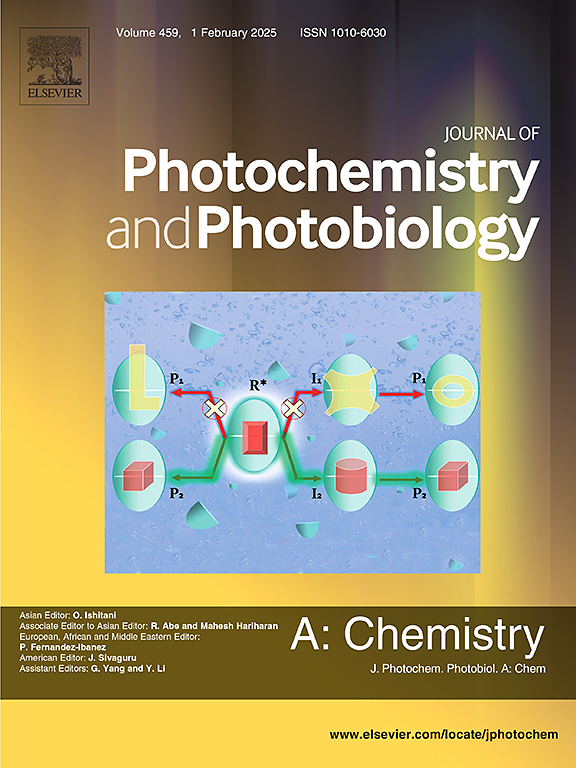zncrce层状双氢氧化物表面改性对层状双氢氧化物衍生混合金属氧化物光降解有机污染物的增强作用
IF 4.1
3区 化学
Q2 CHEMISTRY, PHYSICAL
Journal of Photochemistry and Photobiology A-chemistry
Pub Date : 2025-03-19
DOI:10.1016/j.jphotochem.2025.116398
引用次数: 0
摘要
通过对 ZnCrCe 层状双氢氧化物(ZnCrCe-LDHs)前驱体进行热处理,合成了 ZnCrCe 混合金属氧化物催化剂(ZnCrCe-MMO)。LDH 前驱体通过两种不同的方法进行表面改性:酸蚀和碱蚀,然后进行煅烧,最终分别形成 ZnCrCe-MMO-A 和 ZnCrCe-MMO-B。评估了这些改性对有机污染物(特别是亚甲基蓝染料(MB)和四环素抗生素(TC))光降解效率的影响。研究人员采用多种分析技术,包括 XRD、FT-IR、FE-SEM、TGA、BET、HR-TEM、XPS、DRS、ICP、拉曼分析、EDS 和 Mott-Schottky 分析,对催化剂的合成确认及其物理化学和电化学特性进行了深入研究。本研究首次报道了使用 ZnCrCe-MMO-A 和 ZnCrCe-MMO-B 催化剂光催化降解亚甲基蓝和四环素污染物的情况。此外,利用各种淬灭剂确定了光催化反应过程中中间氧化物种(O2-)的形成,并提出了该过程的潜在机理。结果表明,ZnCrCe-MMO-B 催化剂在光催化去除污染物方面表现出更高的效率。这项研究阐明了金属空位对光降解过程的影响,为实现有机污染物的高效光降解提供了一种可行的方法。本文章由计算机程序翻译,如有差异,请以英文原文为准。

The role of surface modification over ZnCrCe-layered double hydroxide on the enhancing of the photodegradation of organic pollutants by layered double hydroxide-derived mixed metal oxides
The ZnCrCe-mixed metal oxide catalyst (ZnCrCe-MMO) was synthesized through the thermal treatment of ZnCrCe-Layered Double Hydroxides (ZnCrCe-LDHs) precursors. The LDH precursor underwent surface modifications via two distinct methods: acid etching and alkali etching, followed by calcination, resulting in the formation of ZnCrCe-MMO-A and ZnCrCe-MMO-B respectively. These modifications were evaluated for their impact on the photodegradation efficiency of organic pollutants, specifically methylene blue dye (MB) and tetracycline antibiotic (TC). The confirmation of synthesis of the catalysts, along with their physicochemical and electrochemical properties, were thoroughly investigated using a variety of analytical techniques, including XRD, FT-IR, FE-SEM, TGA, BET, HR-TEM, XPS, DRS, ICP, Raman analysis, EDS, and Mott-Schottky analysis. This study reports, for the first time, the photocatalytic degradation of methylene blue and tetracycline pollutants using the ZnCrCe-MMO-A and ZnCrCe-MMO-B catalysts. Furthermore, the formation of intermediate oxidative species (O2̇−) during the photocatalytic reactions was identified using various quenchers, and a potential mechanism for the process was proposed. The results indicate that the ZnCrCe-MMO-B catalyst demonstrates superior efficiency in the photocatalytic removal of pollutants. This research elucidates the effects of metal vacancies on the photodegradation process and offers a promising approach for achieving highly efficient photodegradation of organic pollutants.
求助全文
通过发布文献求助,成功后即可免费获取论文全文。
去求助
来源期刊
CiteScore
7.90
自引率
7.00%
发文量
580
审稿时长
48 days
期刊介绍:
JPPA publishes the results of fundamental studies on all aspects of chemical phenomena induced by interactions between light and molecules/matter of all kinds.
All systems capable of being described at the molecular or integrated multimolecular level are appropriate for the journal. This includes all molecular chemical species as well as biomolecular, supramolecular, polymer and other macromolecular systems, as well as solid state photochemistry. In addition, the journal publishes studies of semiconductor and other photoactive organic and inorganic materials, photocatalysis (organic, inorganic, supramolecular and superconductor).
The scope includes condensed and gas phase photochemistry, as well as synchrotron radiation chemistry. A broad range of processes and techniques in photochemistry are covered such as light induced energy, electron and proton transfer; nonlinear photochemical behavior; mechanistic investigation of photochemical reactions and identification of the products of photochemical reactions; quantum yield determinations and measurements of rate constants for primary and secondary photochemical processes; steady-state and time-resolved emission, ultrafast spectroscopic methods, single molecule spectroscopy, time resolved X-ray diffraction, luminescence microscopy, and scattering spectroscopy applied to photochemistry. Papers in emerging and applied areas such as luminescent sensors, electroluminescence, solar energy conversion, atmospheric photochemistry, environmental remediation, and related photocatalytic chemistry are also welcome.

 求助内容:
求助内容: 应助结果提醒方式:
应助结果提醒方式:


